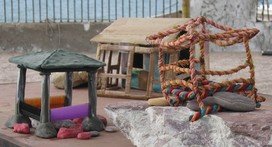Christina Mackie
dal 1/6/2007 al 27/10/2007
Segnalato da
1/6/2007
Christina Mackie
Tate Britain, London
The large huts. Mackie's sculptural installations weave an intricate web of associations between their diverse physical components, which comprise natural, man-made and crafted elements. Her creative processes are often directed by what something can be made to do. Both personal and complex, her works are imbued with her own experience of the world and her private thought processes.

The large huts
Christina Mackie’s sculptural installations weave an intricate web of associations between their diverse physical components, which comprise natural, man-made and crafted elements.
Holding an inherent respect for her materials and an intuitive understanding of the way things work, Mackie’s creative processes are often directed by what something can be made to do. Both personal and complex, her works are imbued with her own experience of the world and her private thought processes.
For Art Now, Mackie has created a new sculpture, The large huts, in the Sculpture Garden outside Tate Britain.
Christina Mackie is best known for her composite sculptural installations which unite disparate elements in a state of temporary synthesis. She has described her works as ‘emotional landscapes’ that attempt to make tangible an atmosphere or abstract sensibility through a materials-based language.
While thematic connections and specific references can often be detected – for example the frequent use of indigenous Canadian materials alludes to the landscape in which the artist grew up – her works cannot be simply decoded through their constituent parts. The origins and wider resonances of each component – be it a red cedar wood panel split down the grain, remnants of her old clothing stitched into ropes, or a video projection – remain secondary to their formal function within the overall structure of an installation. Mirroring the labyrinthine nuances of private thought patterns, only fully evident to Mackie herself, these works eschew any sort of narrative containment or defi nition, shooting off in a hundred directions. Yet her meticulous process of layering and construction mobilises a subtle chain of associations in which autonomous things relate to one another quite naturally, as they do in our daily experience.
While Mackie’s creative decisions stem from her subjective experience of the world, they are shaped by a pragmatic and intuitive approach to her materials and what they can be made to do. Typically held in place by gravity and balance rather than glue, her constructions convey a sense of impermanence and momentary stasis arising from the intimation that they can at any moment be taken apart and reassembled afresh.
The large huts, conceived especially for Tate Britain’s Sculpture Court, represents something of a departure for Mackie. Working in collaboration with a fabrication specialist, she exchanged her customary process of slow assemblage for one of carving, sculpting and moulding. Characteristically, this change was driven by necessity and has its roots in a residency in Pakistan which she completed last year. There, finding manufactured materials in scarce supply, Mackie began experimenting with the grey clay from the Indus Valley and found the freedom to explore and develop more traditional sculptural techniques. This resulted in a series of clay maquettes based on drawings she had made of the concrete sun shelters that punctuate Gadani Beach, a once popular tourist destination now suffering the effects of the decline of its ship-breaking industry. Scaled up to twenty times their original size, these simple, elementary structures are pitched against the sophisticated neoclassical façade of Tate Britain inviting a complex interplay of parallels and contrasts to unfold.
Deposited in a seemingly haphazard fashion on the lawn adjacent to the east wing of the building, the three huts appear to have been swept in on a tide of lava, or washed up like marine debris on a shore. The enormous clod-like mounds attached to their bases, which constitute approximately half their overall height, suggest both a parasitic and organic attachment to the earth from which they have been shaped and subsequently wrenched. The tent-like form of the shelters offers crude echoes of the porticos on the façade of the gallery while simultaneously reinforcing their remove. Against the building’s orderly symmetry and clean lines, the huts possess an anarchic, raw and visceral quality, both ancient and timeless.
Implicit in the work, and in its proximity to Tate Britain, are resonances of a colonial heritage. One is reminded not only of the skill and expertise invested in the creation of the building itself – from the foundation stone up – but also of all it contains and symbolises: a manifestation of British wealth and power, and a gallery devoted to the high Victorian ideals of cultural edification and intellectual accomplishment.
Text by Lizzie Carey-Thomas
Image: Gadani Huts 2006, courtesy Herald Street © Christina Mackie
Tate Britain
Millbank London



